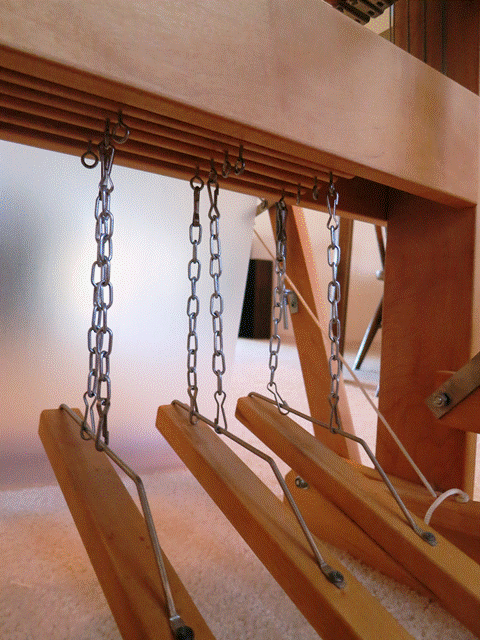Why do you have to be a nonconformist
like everybody else?
~ James Thurber
Given that these rugs are kind of "bonus" rugs, I decided to experiment with different weave patterns.
Now, there are two primary components that contribute to the weave pattern that you produce with a loom. The first is the sequence with which you thread the warp (lengthwise threads) in the hanging needles in the four different frames. This is during the preparation of the loom.
Once you do that with a warp, you can't easily change it for anything that you want to weave with that warp - you are stuck with it.
I used a basic threading pattern - I put the first 4 warp threads through frames 4, 3, 2 and 1 respectively and then repeated that pattern over and over again.
The other main component is the sequence in which you lift the frames by pressing on the pedals while you are actually weaving. AND, you can monkey with this as often as you like! EVEN on the SAME stripe of one rug! ;)
Finally, you can go "plain jane" and have each pedal life one frame OR you can hook different pedals up to different combinations of frames, so that 1 pedal can lift 1, 2 or 3 frames. I've tried to show that in this picture:
Can you see how the 4 frames have little hooks on their bottoms? And how the pedals have lightweight chains hooking the pedals to different frames? In this picture, each pedal is controlling 2 frames.
Finally, the outcome of different patterns of warp threadings and pedal-work are illustrated in these cool graphics:
The "4, 3, 2, 1" that you see repeated across the top represents how the warp threads are threaded through the frames.
The "4, 3, 2, 1" repeated along the right side represents the pattern of stepping on pedals.
The little "0"s in the upper right corner show how to connect the pedals to the frames.
And the beautiful blue and white pattern that covers almost the entire page, presumably shows you what pattern you'll end up weaving!
However, this pattern assumes that the warp threads (white) and the weft threads (blue) are of equal thickness - notice how the white squares and the blue squares are the same size?
With my rag rugs, the white cotton warp thread is much thinner than the thick, recycled t-shirt yarn weft threads. Hence, when I follow this pattern, here is what I get:
The other pattern I've tried so far is this chevron-like pattern:
Notice that the "4, 3, 2, 1" across the top is the same, but now I need to use all 6 pedals instead of just 4 (column on the right side) and the hook up between the pedals and the frames (upper right hand corner) is also different.
And, with my thin white warp threads and some thick aqua weft threads, this is what I got:
Given the different widths of my warp and weft, it is hard for me to imagine ahead of time how a pattern will end up looking with my particular threads - I just know it will look different from the picture shown.
But I kind of like how the chevron-y pattern came out. :)
I know it's not typical for a rag rug to have a fancy weave pattern - but I've kind of given up on expecting anyone to put the word "typical" on my tombstone anyways... ;)






No comments:
Post a Comment